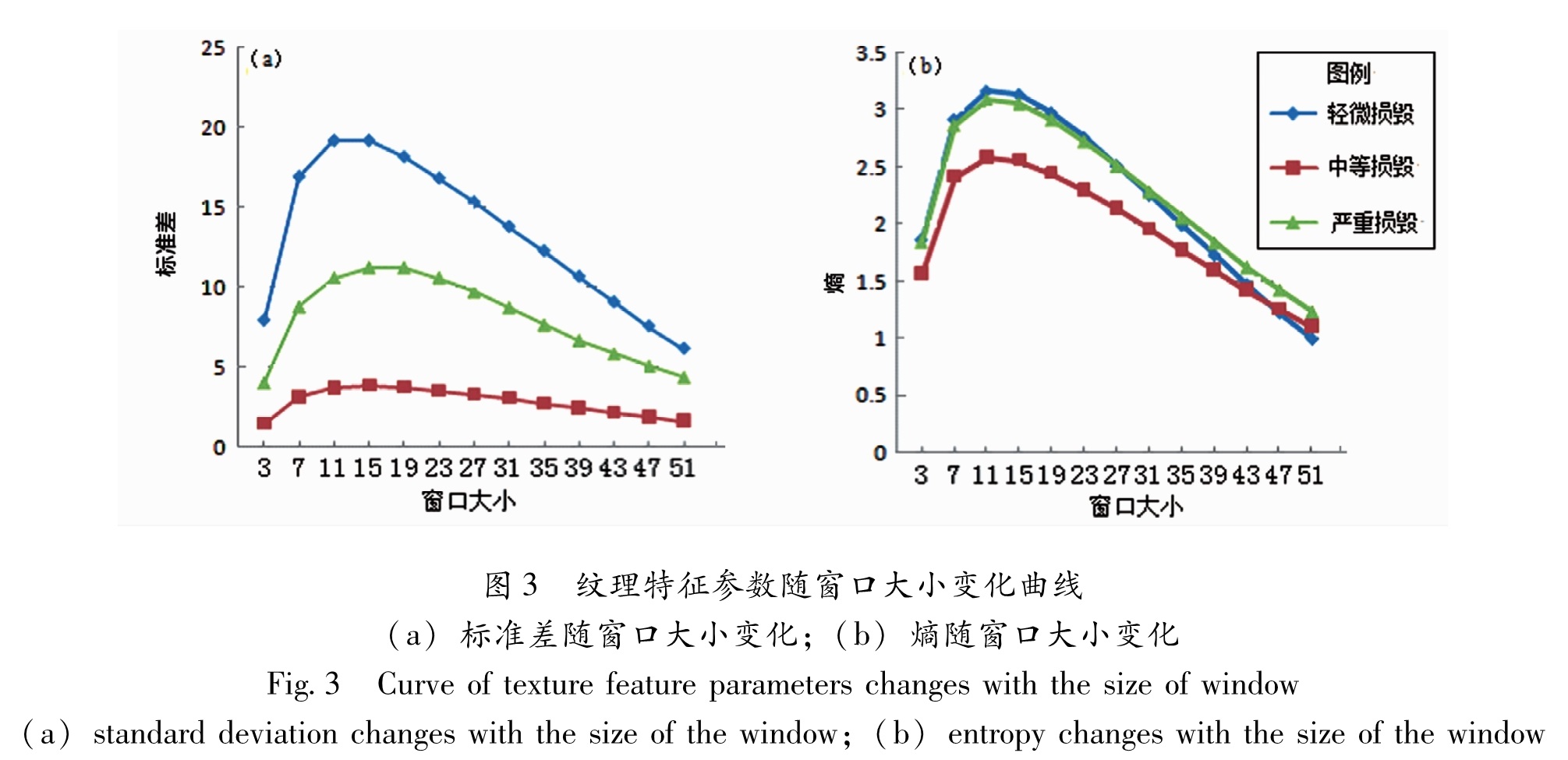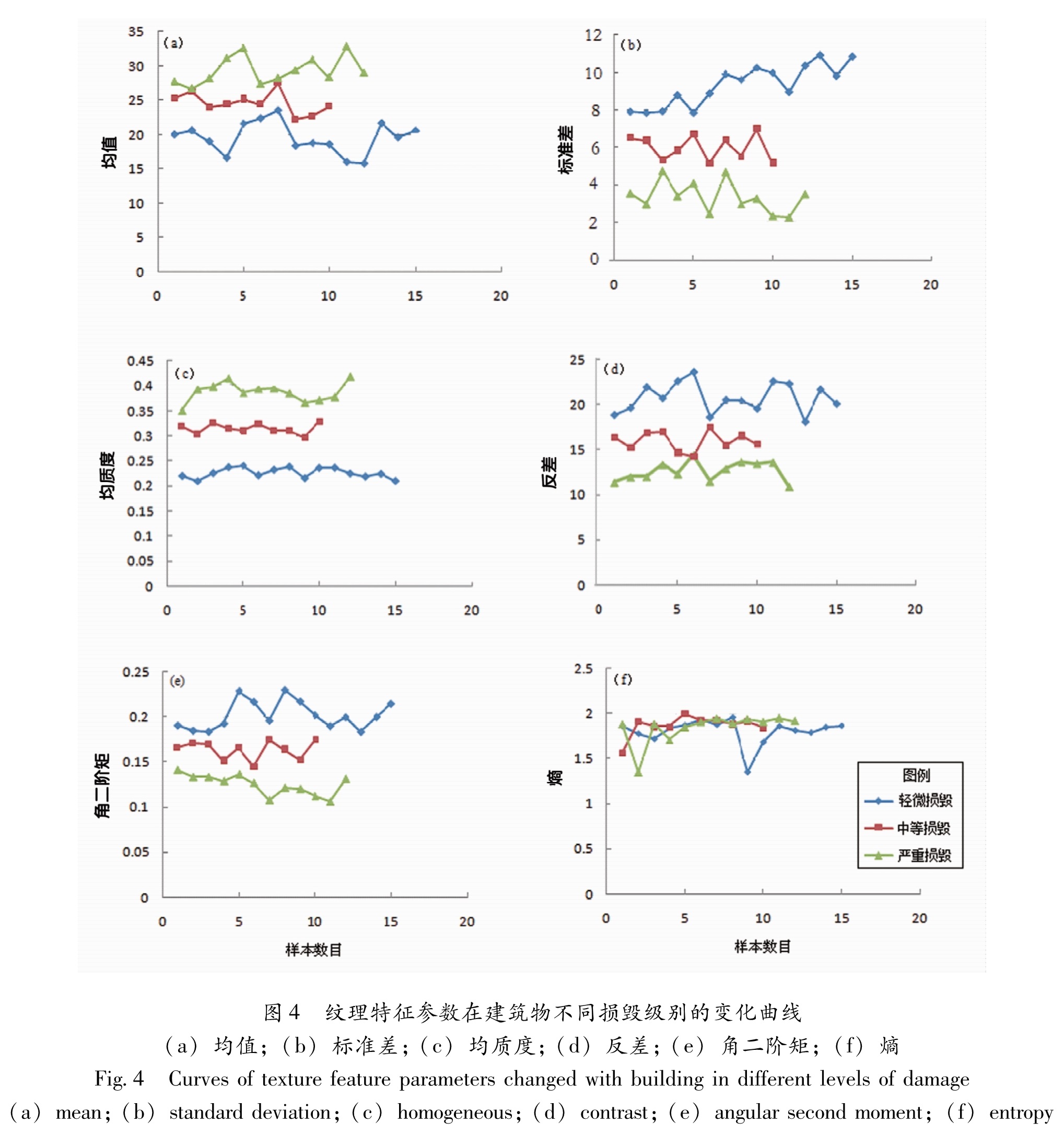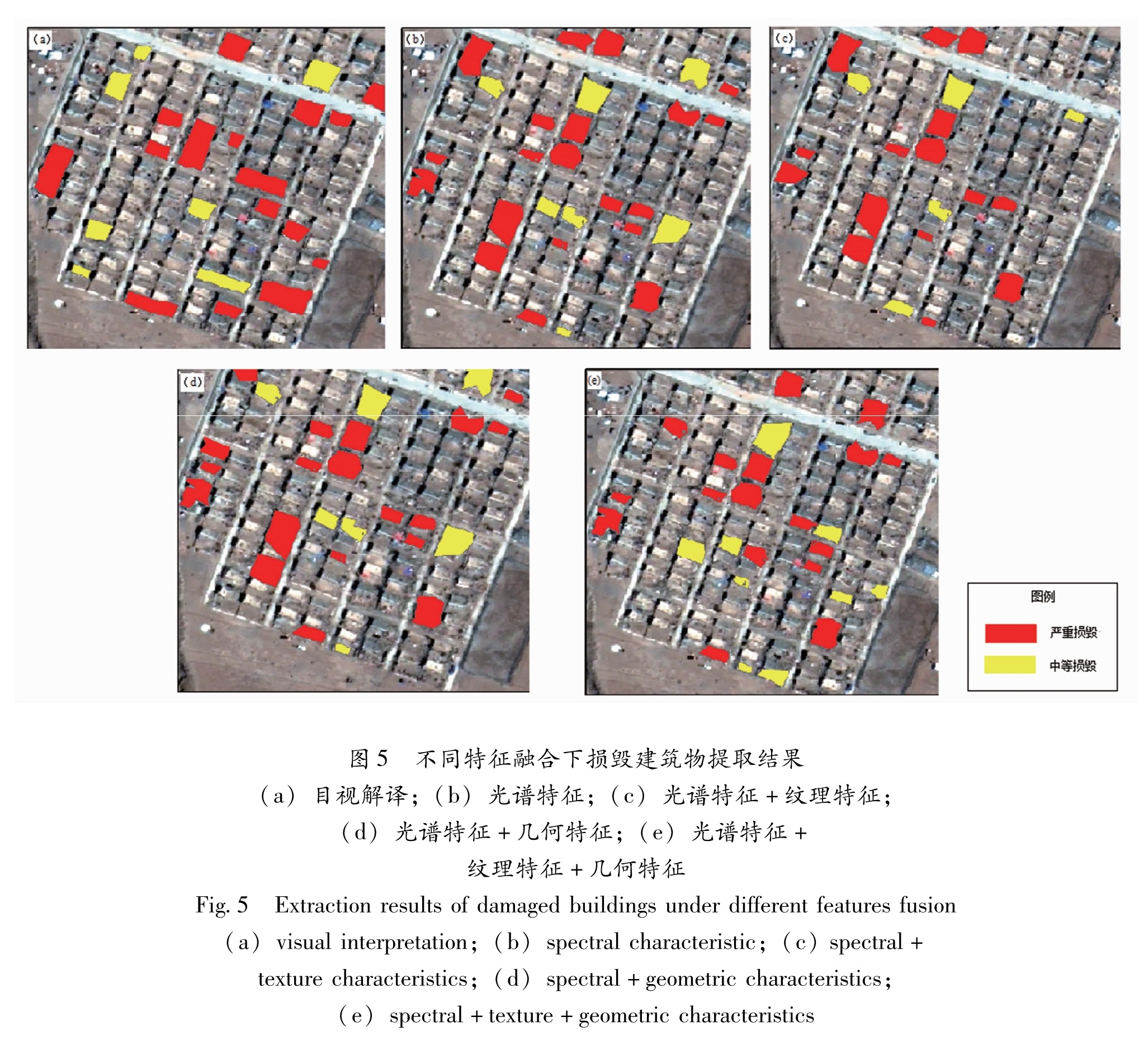基金项目:国家高技术研究发展计划(2012AA121304)资助.
(1.中国地震局工程力学研究所,黑龙江 哈尔滨 150080; 2.中国地震局地壳应力研究所,北京 100085)
(1. Institute of Engineering Mechanics, CEA, Harbin 1500801, Heilongjiang, China)(2.Institute of Crustal Dynamics, CEA, Beijing 100085, China)
remote sensing image; multi-feature fusion; texture feature; damaged buildings
备注
基金项目:国家高技术研究发展计划(2012AA121304)资助.
采用玉树地震QuickBird影像,对不同损毁级别的建筑物进行采样分析,提取不同损毁情况表征纹理特征的灰度共生矩阵中区分度较好的特征参数。比较不同特征融合之后损毁建筑物提取精度。结果 表明,灰度共生矩阵中纹理特征参数对不同损毁程度的建筑物具有不同的区分度,光谱特征与纹理特征结合,损毁建筑物识别精度最高,不同的特征参数混淆使用会造成信息冗余,从而降低信息提取精度。在实际工作中,要根据遥感震害机理选取合适的特征组合,提高损毁建筑物的提取精度。
Firstly, using QuickBird image of Yushu Earthquake, we extracted characteristic parameters which have better discrimination in the gray level co-occurrence matrix(GLCM)characterized by texture features in different damage situation through sampling and analysis of buildings in different damage level. And then on the basis of it, we compared the extraction accuracy of damaged buildings by using the different features merged. The results show that the texture features parameters in GLCM have different distinguish on the buildings in different damage degree. Combined the spectral feature with texture feature, the identification precision of the damaged building is highest, however, the confusion of different characteristic parameters may lead to redundant information, resulting in reducing the accuracy of the extracted information. In practice working, based on remote sensing mechanism of damage, we should select the appropriate feature combination to improve the extraction accuracy of damaged buildings.
引言
地震具有突发性强、破坏性大的特点,会对人民的生命财产安全造成不可弥补的损失。地震发生后,进行震区破坏程度快速准确的评估,特别是损毁建筑物的快速提取,对震后紧急救援及灾情评估有重要的意义。遥感具有综合、宏观、快速、动态的特点,是震害灾情信息快速获取的重要数据源(赵福军,张磊,2009)。随着遥感技术及影像分辨率的不断提高,遥感影像能够反映更加丰富的空间结构信息和纹理信息,可有效地提取损毁建筑物信息,使得融合影像的不同特征对遥感影像进行精确识别分类成为研究趋势。
损毁建筑物信息的提取方法主要有遥感影像的变化检测和分类技术,包括震前、震后影像对比分析和直接从遥感影像中提取建筑物损毁信息(赵福军,张磊,2009)。国内外学者在此理论基础上展开了一系列的研究,Masashi和Fumio(1998)利用神户地区地震后的TM影像和SPOT影像,采用判别式从遥感影像中提取了损毁建筑物、震后火灾分布及土壤液化等信息; Hajime和Fumio(2000)根据土耳其Kocaeli地震和我国台湾震后影像特征的分布,利用多尺度分割的方法提取震害信息,其参与的特征主要有色调、饱和度、亮度和边缘特征。随着多特征及多源遥感数据的发展,越来越多的研究者将影像的纹理特征、几何形状特征等信息融合进来,提高信息提取的精度; 李祖传等(2010)利用高分辨率影像的纹理与形态特征实现对汶川地震倒塌房屋信息的自动提取; 吴炜等(2012)将建筑物的光谱特征和形状特征相结合对建筑物进行提取,与单独用光谱特征相比,提取精度较高; 徐佳等(2012)综合灰度与纹理特征对高分辨率星载SAR图像进行建筑物提取,提取效果良好; 曹代勇等(2001)对遥感影像中建筑物灰度特征和纹理特征进行统计,统计结果表明灰度平均值、灰度标准差和灰度方差3种特征参数是建筑物震害识别和分级的良好指标,同时将震害建筑物遥感评估类型概括为三种; 翟永梅等(2011)提出了一种基于区域的遥感影像差值分割提取技术来快速地对震害信息进行评估,应用效果良好。近年来,随着高分辨率遥感技术的快速发展,面向对象的方法由于克服了常规的仅依靠像元的光谱统计特征提取相关信息的不足,从而受到广大研究者的青睐。Hofmaane(2001)利用面向对象的方法,以DEM作为一个专题层参与遥感影像的分割,实现了对IKONOS影像中建筑物与道路的提取; 赵福军和张磊(2009)利用面向对象的方法对汶川地震震害信息进行提取,取得了较好的结果; 王慧敏和李艳(2011)利用面向对象的方法对海地地震灾害造成的损毁建筑物进行提取; 龚丽霞等(2013)利用面向对象变化检测的方法提取玉树地震造成的房屋倒塌,同时与主成分分析、直接变化检测方法相比,提取精度较高; 范开红等(2014)利用面向分类技术对应急指挥技术系统信息进行产出与模块化,从而更及时地掌握震情、灾情,使得面向对象思想适用于地震应急。上述的研究取得了一定的成果,将建筑物的光谱特征、形状特征、纹理等特征结合起来,提高了建筑物信息提取精度,同样也存在着不足,建筑物的纹理特征、形状特征、光谱特征的结合主要依靠人为经验进行选取,没有一定的规律可循。建筑物的纹理特征、形状特征包含的特征参数繁多,特征参数的选取依靠人为主观经验,要依靠不断的试验进行选取,耗费大量的时间。
如何有效地对损毁建筑物的纹理特征、形状特征、光谱特征等多特征进行融合,快速从繁多特征参数中选取最优参数组合,是震害信息快速准确提取的重点。本文从高分辨率遥感影像中选取不同震害程度的建筑物样本,对其各种特征信息进行统计分析,获取多特征信息的最优组合,快速准确地提取震后损毁建筑物信息。
1 建筑物震害图像特征
1.1 建筑物震害分级不同烈度及破坏强度的地震对建筑物的损毁情况不同。根据《震害调查及地震损失评定工作指南》国家地震局.1993.震害调查及地震损失评定工作指南.和《建(构)筑物地震破坏等级划分》(GB/T24335—2009),建筑物震害等级分为5个级别,分别为基本完好、轻微破坏、中等破坏、严重破坏和损毁。遥感图像提供的是建筑物外形的中心投影信息,遥感图像分级主要依据震后建筑物的整体和细部图像特征,包括图像的几何信息、色调信息和相关信息(陈鑫连,1992)。因光学遥感成像方式的局限性,遥感影像中不能获取建筑物墙体或内部的损毁信息,因此,本文将震害建筑物损毁级别分为3级,轻微损毁、中等损毁和严重损毁。轻微损毁是指采集样本影像中房屋基本完好或少量破坏; 中等损毁是指采集样本影像中一半数量的房屋倒塌或破坏; 严重损毁是指采集样本影像中绝大部分房屋倒塌或全部倒塌破坏。
1.2 建筑物特征(1)光谱特征
光谱特征是指不同波段、不同传感器、不同时相遥感影像上地物光谱特征的空间集合,主要包括灰度、色调及颜色等。反映建筑物震害光谱特征的特征参数主要有灰度均值、灰度方差、灰度标准差、最大值和最小值。一般而言,建筑物损毁之后,建筑物的镜面反射变弱、漫反射加强,其灰度均值较大。建筑物损毁程度越严重,其灰度均值越大,而其方差及标准差越小。
(2)纹理特征
本文采用共生概率纹理特征来提取纹理特征,共生概率纹理特征是一种基于统计的纹理描述方法,利用灰度共生矩阵(grey-level co-occurrence matrix,简称GLCM)描述纹理特征。共生概率纹理特征最早由Haralick等用灰度共生矩阵的方法提出(Pesar,Benediktsso,2001)。灰度共生矩阵是像素距离和角度的矩阵函数,它通过计算图像中一定距离和方向的两点灰度之间的相关性,来反映图像在方向、间隔、变化幅度及快慢上的综合信息。反映建筑物震害纹理特征的特征参数主要有均值(ME)、方差(VA)、反差(CON)、熵(ENT)、均质度(HOM)、相异度(DI)、相关性(COR)、角二阶矩(ASM)。
均值能够反映图像灰度局部变化情况:
ME=∑N=Ji,j=0i×Pi,j.(1)
方差是像元值与均值偏差的度,以灰度共生矩阵形式表示:
VA=∑N-1i,j=0i×Pi,j(i-ME)2.(2)
反差反映了图像的清晰度和纹理沟纹的深浅程度:
CON=∑N-1n=0n2{∑N-1i=0∑N-1 j=0
|i-j|=nPi,j /( / )}.(3)
熵表示图像中纹理的非均匀程度或复杂程度,是图像所具有的信息量的度量,是一个随机性的度量:
ENT=∑N-1i=0∑N-1j=0Pi,jlogpi,j.(4)
均质度反映图像纹理的同质性,度量图像纹理局部变化量:
HOM=∑N-1i=0∑N-1j=0Pi,jPi,j/[1+(i-j)2].(5)
相异度与反差呈线性相关,局部反差越大,相异性越大:
DI=∑N-1i,j=0i×Pi,j|i-j|.(6)
相关性用来度量空间灰度共生矩阵元素在行或列方向上的相似程度:
COR=[∑N-1i=0∑N-1j=0ijPi,j-u1u2]/σ1σ2.(7)
其中,
u1=∑N-1i=0i∑N-1j=0Pi,j,
u2=∑N-1j=0j∑N-1i=0Pi,j,
σ21=∑N-1i=0(i-u1)2∑N-1j=0Pi,j,
σ22=∑N-1j=0(j-u2)2∑N-1i=0Pi,j.
角二阶矩是灰度共生矩阵元素值的平方和,反映了图像灰度分布均匀程度和纹理粗细度:
ASM=∑N=Ji,j=0i×Pi,j2.(8)
ASM是灰度共生矩阵元素值的平方和,反映了图像灰度分布均匀程度和纹理粗细度。
以上各式中,i,j=0,1,2,3……(N-1),N为图像灰度级数,μ代表均值,σ代表方差,Pi,j代表从图像灰度为i的像素出发,统计与距离为δ,灰度为j的像素出现的概率。
(3)几何形状特征
建筑物的几何特征主要指建筑物的形状以及以几何关系为基础的特征,通常包括建筑物屋顶形状的轮廓线、屋顶轮廓边缘相互之间的夹角、屋顶面积、侧墙棱线等(张明媚,2012)。反映震害建筑物几何形状特征的特征参数主要有面积(Area)、长度(Length)、宽度(Width)、长宽比(Aspect-ratio)、形状指数(Shape-index)、紧致度(Compactness)、矩形度(Rectangular-degree)等。
面积是一个像元覆盖的真实面积乘以影像对象的像元数量:
Area=1/n∑ni=1ai.(9)
长度由影像对象的外接矩形的长宽比来计算:
Length=(Area·r)1/2.(10)
宽度用影像对象的外接矩形的长宽比来计算:
Width=(Area/r)1/2.(11)
长宽比是形状协方差矩阵特征值的比值:
Aspect-ratio=Length/Width.(12)
形状指数是影像对象的边界长度除上它的面积的平方根的4倍:
Shape-index=e/(4(Area)1/2).(13)
紧致度是对象的长乘以宽,再除以对象的像元个数:
Compactness=(n·m)/a.(14)
矩形度是矩形外的对象面积和矩形内的未被对象填充的面积比:
Rectangular-degree=(Rout)/(Rin).(15)
震前完好建筑物遥感影像中灰度分布均匀,几何外形特征规整,具有清晰的纹理特征。地震对建筑物造成不同程度的破坏,建筑物倒塌后,由于破碎而使镜面反射减弱,使得影像中灰度分布由亮变暗,建筑物的几何形态也会发生变化,边界变得模糊不清,纹理特征不明显或不清晰。
2 实验与分析
2.1 训练区样本选择本文选择2010年玉树地震后玉树县结古镇的Quick-Bird 影像为研究对象,研究区遥感影像图见图1。研究区房屋大面积倒塌,一些地方几乎夷为平地,震害类型主要为建筑物损毁。研究区影像大小为1 792×2 048,影像分辨率为0.6 m。
根据遥感影像中建筑物的分类规则,选取轻微损毁、中等损毁、严重损毁三个等级的建筑物样本,样本选择时遵循特征参数在同类型样本中稳定的原则,按照此原则,总共选择37个样本,其中基本完好、中等损毁、严重损毁的个数分别为15、10、12,选取样本示例如图2所示。2.2 最优窗口选择纹理特征采用灰度共生矩阵来描述。灰度共生矩阵与所选的方向、步长、窗口大小及图像的量化等级有关,因此要根据具体的影像纹理特征来选择生成灰度共生矩阵的参数。根据经验,取0°、45°、90°和135°这4个方向灰度共生矩阵的平均值作为局部图像中心像元位置的灰度共生矩阵。图像的量化等级变化对影像的灰度共生矩阵影响不大,本研究中设定图像量化等级为64。在灰度共生矩阵分析过程中,步长越小越能细致地反映纹理特征,因此本文选取步长为1。对其影响最大的为窗口大小,本文将建筑物震害类型分为3种:轻微损毁、中等损毁和严重损毁,分别统计3种样本在不同窗口大小下的参数特征值,从而选取样本特征参数区分度较好的窗口大小,以标准差、熵为例说明选取最优窗口大小。以4为间隔依次采用3×3到51×51之间的窗口大小,统计计算不同窗口大小的标准差和熵,研究建筑物震害的不同特征值随窗口大小变化的趋势,趋势变化图见图3。由图可知,当窗口大小为11×11时,不同级别损毁建筑物的特征值达到最大,标准差的区分度较好,而熵值特征中,轻微损毁和中等损毁情况混在一起,但两者与严重损毁的区分度较好,有利于提取严重损毁建筑物信息。因此本研究中,灰度共生矩阵计算的窗口大小尺寸选择11×11。
2.3 纹理特征分析遥感影像不同的纹理特征反映不同的建筑物损毁信息。前人研究表明,将纹理信息与光谱信息结合提取损毁建筑物信息能提高提取精度。通常反映影像纹理特征参数有8个,其全部参与运算必然会造成信息冗余,如何从这8个参数中选取最优的特征参数组合计算,成为研究的重点。本文首先计算不同样本的纹理特征参数,窗口大小取11×11,然后对其进行统计分析,提取出最能反映建筑物损毁信息的特征参数组合。图4为不同级别损毁建筑物样本不同纹理特征参数值的趋势变化曲线,由图可知,建筑物在不同损毁情况下,均值、标准差、均质度、反差、角二阶矩的区分度明显,能很好的区分轻微、中等和严重损毁建筑物信息,可损毁建筑物的提取,而熵的区分度并不特别明显,其值分布在一个比较集中的值范围内,不同损毁程度的建筑物特征混淆在一起,未能较好地区分。因此在本文研究中,纹理特征参数选择均值、标准差、均质度、反差、角二阶矩、熵。
2.4 建筑物震害提取不同类型或损毁程度的建筑物光谱差异很大,单纯依靠基于光谱的遥感图像分类方法难以将其区分开,面向对象的方法首先将影像按照一定的阈值尺度分割为很多小的对象,然后综合其光谱统计特征、纹理特征、形状特征、相邻关系等因素,将具有相同特征的小的对象构成一个影像对象,最后根据影像对象的不同特征进行分类,打破了仅依靠光谱特征进行分类的局限性。在信息提取的过程中,不同的特征因子对信息提取的贡献不同(Du, Liu,2012),并不是越多的特征融合在一起,其信息提取精度就越高。本文研究中对多特征的不同组合情况进行实验比较,主要包括光谱特征、光谱特征+纹理特征、光谱特征+几何形状特征、光谱特征+纹理特征+几何形状特征。
根据上面的研究,本文纹理特征参数选择均值、标准差、均质度、反差、角二阶矩和熵。几何形状特征的特征参数主要有面积、长度、长宽比、紧致度、矩形度。光谱特征采用原始的四个波段。本文采用相同的分割尺度,融合不同的特征,对其提取精度进行对比。
图5为4种不同特征融合之后损毁建筑物提取结果,在相同的分割尺度下,统计严重损毁与中等损毁建筑物面积,与目视解译的结果进行对比,分析其提取精度,结果见表1.
(a)visual interpretation;(b)spectral characteristic;(c)spectral+图5 不同特征融合下损毁建筑物提取结果
(a)目视解译;(b)光谱特征;(c)光谱特征+纹理特征;
(d)光谱特征+几何特征;(e)光谱特征+
纹理特征+几何特征
Fig.5 Extraction results of damaged buildings under different features fusiontexture characteristics;(d)spectral+geometric characteristics;
(e)spectral+texture+geometric characteristics
表1 不同特征融合损毁建筑物提取精度比较
Tab.1 Comparison of extraction accuracy of the damaged buildings under different features fusion由表1可以看出,光谱与纹理特征相融合之后提取损毁建筑物的Kappa系数最大,同时完好错分为损毁的百分比最低,说明其信息提取效果最好。分析其原因,建筑物在损毁之后,其纹理特征发生了明显的变化,与周围地物的纹理特征具有明显差别,这可从图4中纹理特征变化趋势曲线的区分度得出。而仅仅依靠光谱特征提取建筑物损毁信息,由于存在异物同谱的现象,其信息提取精度最低。建筑物在破坏或倒塌之后,其几何形状特征中的面积、长度、形状指数和矩形度等特征都受到不同程度的影响,建筑物面积变大或者与周围空地(道路)融合一体,建筑物形状受到破坏,很难用具体的参数来表示,同时由于影像分辨率的影响,损毁建筑物易与周围裸地或崩落的碎屑混为一体,同样也会影响提取精度,因此,融合几何形状特征不但没有提高提取精度,反而会降低提取精度。而融合光谱特征、纹理特征和几何形状特征融合之后,损毁建筑物的漏检率最低,同时其完好建筑物错分为损毁的百分比最高。
实验证明,在影像分辨率一定时,影像多特征融合提取损毁建筑物精度与融合信息量并不成正比关系。在提取完好建筑物信息时,其几何形状特征规整,几何形状特征参数能较好地表述建筑物的几何形态分布,融合几何形状特征会提高建筑物信息提取的精度。而在地震发生之后受到严重损毁的建筑物,其形状受到破坏,几何形状特征参数不能很好地赋予其一定的特征值范围,融合几何形状特征并不能提高其提取精度。因此,建筑物信息提取要充分考虑影像分辨率、建筑物分布形态及其内部纹理变化,从而选择最优融合特征。
3 结论
本文以玉树地震遥感影像为例,针对遥感影像中建筑物损毁情况,总结分析了不同损毁等级建筑物在遥感影像中表现出的纹理特征、几何形状特征等参数因子。选取不同等级损毁程度的建筑物样本,统计分析其纹理特征参数在不同损毁等级下的变化趋势曲线,同时比较了多种特征融合提取损毁建筑物的提取精度。通过实验与分析,得出以下结论:
(1)表征纹理特征的灰度共生矩阵的8个特征因子,并不是每一个特征因子都对不同损毁程度的建筑物具有很好的区分度,本文通过采样统计分析表明,灰度共生矩阵中均值、标准差、均质度、反差、角二阶矩特征因子对损毁建筑物区分度较好。
(2)并不是特征信息融合越多,损毁建筑物提取精度越高,比较几种特征融合提取损毁建筑物的精度,发现光谱信息与纹理信息融合对损毁建筑物的提取精度最高。地震发生之后,精确地提取损毁建筑物信息,需要全面地考虑其分布形态及纹理变化,有选择性地进行特征融合,常规的将所有信息进行融合的方法可能会降低提取精度。
- 曹代勇,施先忠,张景发. 2001.遥感图像中建筑物震害信息统计特征研究[J].国土资源遥感,13(1):42-46.
- 陈鑫连. 1992.地震灾害的航空遥感信息快建评估与救灾决策[M].北京:地震出版社.
- 范开红,林洋,申源.2014.地震应急指挥技术系统产出信息面向对象分类与应用[J].地震研究,37(2):317-322
- 龚丽霞,李强,张景发等. 2013. 面向对象的房屋震害变化检测方法[J].地震,33(2):109-114.
- 李祖传,马建文,张睿等. 2010.利用融合纹路与形态特征进行地震倒塌房屋信息自动提取[J].武汉大学学报,35(4):446-450.
- 王慧敏,李艳. 2011.面向对象的损毁建筑物提取[J].遥感信息,26(5):81-85.
- 吴炜,骆剑承,沈占峰等. 2012.光谱和形状特征相结合的高分辨率遥感图像的建筑物提取方法[J].武汉大学学报,37(7):800-805.
- 徐佳,陈媛媛,黄其欢等.2012.综合灰度与纹理特征的高分辨率星载SAR图像建筑区提取方法研究[J].遥感技术与应用, 27(5):692-698.
- 赵福军,张磊. 2009.面向对象的遥感震害信息提取方法——以汶川地震为例[J].地震, 29(增刊):130-138.
- 张明媚. 2012.面向对象的高分辨率遥感影像建筑物特征提取方法研究[D].太原:太原理工大学.
- 翟永梅,王森,沈祖炎等.2011.一种快速的震害评估方法——基于区域的遥感影像差值分割提取技术研究[J].地震研究,34(2):227-232.
- Du P, Liu S C. 2012.Change detection from multi-temporal remote sensing images by integrating multiple features[J].Journal of Remote Sensing, 16(4):663-677.
- Hajime M,Fumio Y.2000.Masashi Matsuoka.Automated detection of building damage due to recent earthquakes using aerial television images[C]//Proceedings of the 21st Asian Conference on Remote Sensing.Taiwan:Taipei:1-7.
- Hofmann P. 2001.Detecting buildings and roads from IKONOS data using additional elevation information[J]. GeoBIT/GIS,6: 28-33.
- Pesar esi M, Benediktsso n J A. 2001. A New Approach for the Morph logical Segmentation of High resolution Satellite Imagery [J]. IEEE Transactions on Geo science and Remote Sensing,39(2):309-320.
- Masashi M,Fumio Y. 1998. Identification of Damaged areas Due to the 1995 Hyogoken-Nanbu Earthquake Using Satellite Optical Images[C]//Proceedings of the 19th Asian Conference on Remote Sensing.Q9[C]:1-6.
- GB/T 24335—2009,建(构)筑物地震破坏等级划分[S].






